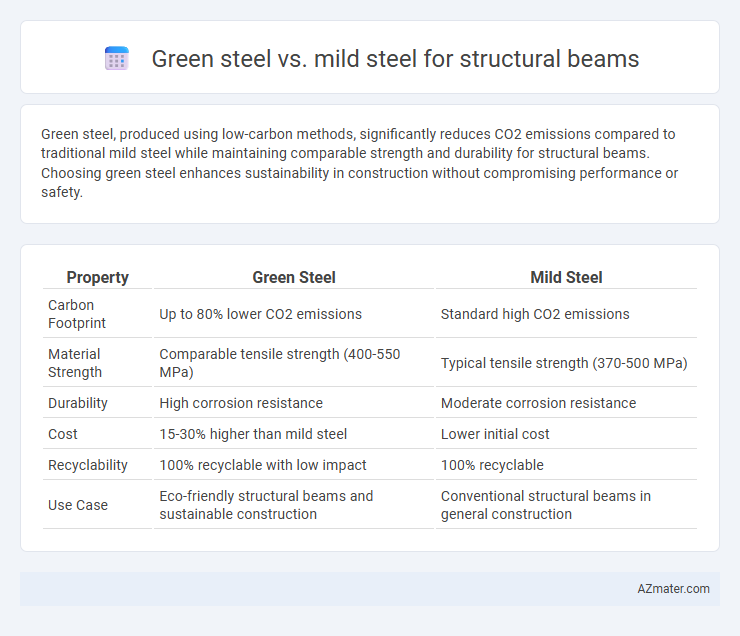Green steel, produced using low-carbon methods, significantly reduces CO2 emissions compared to traditional mild steel while maintaining comparable strength and durability for structural beams. Choosing green steel enhances sustainability in construction without compromising performance or safety.
Table of Comparison
| Property | Green Steel | Mild Steel |
|---|---|---|
| Carbon Footprint | Up to 80% lower CO2 emissions | Standard high CO2 emissions |
| Material Strength | Comparable tensile strength (400-550 MPa) | Typical tensile strength (370-500 MPa) |
| Durability | High corrosion resistance | Moderate corrosion resistance |
| Cost | 15-30% higher than mild steel | Lower initial cost |
| Recyclability | 100% recyclable with low impact | 100% recyclable |
| Use Case | Eco-friendly structural beams and sustainable construction | Conventional structural beams in general construction |
Introduction to Green Steel and Mild Steel
Green steel, produced using low-carbon technologies such as hydrogen-based direct reduction, offers a sustainable alternative to traditional mild steel by significantly reducing CO2 emissions during manufacturing. Mild steel, an alloy primarily composed of iron with a low carbon content (typically 0.05-0.25%), is extensively used in structural beams due to its strength, ductility, and affordability. Comparing both materials involves evaluating environmental impact, mechanical properties, and lifecycle performance for optimized structural applications.
Composition and Manufacturing Processes
Green steel is primarily composed of recycled steel and produced using electric arc furnaces powered by renewable energy, significantly reducing carbon emissions compared to traditional methods. Mild steel for structural beams is typically made from iron and a small percentage of carbon (around 0.05-0.25%) and manufactured through blast furnaces that utilize coke and coal, resulting in higher environmental impact. The manufacturing process of green steel emphasizes sustainability by integrating direct reduced iron (DRI) and hydrogen-based steelmaking, which contrasts with the conventional blast furnace-basic oxygen furnace (BF-BOF) route used for mild steel production.
Environmental Impact Comparison
Green steel significantly reduces carbon emissions by using renewable energy and hydrogen-based production methods, resulting in up to 95% lower CO2 footprint compared to traditional mild steel manufacturing. Mild steel production relies heavily on coal and blast furnaces, contributing substantially to greenhouse gas emissions and environmental pollution. The environmental impact comparison highlights green steel as a sustainable alternative for structural beams, promoting reduced ecological damage and enhanced resource efficiency.
Structural Properties and Performance
Green steel, produced with lower carbon emissions and recycled materials, often matches or surpasses mild steel in structural properties such as tensile strength and durability. Its performance in structural beams demonstrates high resistance to corrosion and fatigue, ensuring long-term stability in construction applications. Mild steel remains widely used for its ductility and ease of fabrication, but green steel's enhanced sustainability and comparable mechanical properties position it as a superior choice for eco-friendly structural solutions.
Cost Analysis and Economic Considerations
Green steel, produced using low-carbon methods like hydrogen reduction or electric arc furnaces powered by renewable energy, typically incurs higher upfront costs compared to conventional mild steel due to limited production scale and advanced technologies. Mild steel remains more economically viable for structural beams because of its widespread availability, lower material costs, and well-established manufacturing processes, which translates to reduced capital expenditure for construction projects. Long-term economic considerations for green steel include potential savings from carbon taxes, regulatory incentives, and improved sustainability credentials that may offset initial price premiums in future infrastructure investments.
Sustainability and Lifecycle Assessment
Green steel, produced using renewable energy and low-carbon processes like hydrogen-based direct reduction, significantly reduces CO2 emissions compared to traditional mild steel made from blast furnace routes. Lifecycle assessment (LCA) reveals that green steel's environmental impact is minimized during raw material extraction, manufacturing, and end-of-life recycling phases, resulting in a lower carbon footprint and enhanced sustainability for structural beams. Consequently, green steel supports circular economy principles by enabling steel reuse and reducing reliance on fossil fuels throughout the structural beam lifecycle.
Availability and Market Trends
Green steel, produced using environmentally friendly methods such as hydrogen reduction, is gaining availability in limited quantities as major steel producers invest in sustainable technologies. Mild steel remains widely available and dominates the structural beam market due to established manufacturing processes and lower costs. Market trends indicate increasing demand for green steel driven by regulatory pressures and corporate sustainability goals, encouraging gradual expansion of green steel supply chains.
Regulatory Standards and Certifications
Green steel structural beams comply with emerging environmental standards such as the International EPD System and the ResponsibleSteel certification, ensuring lower carbon footprints and sustainable sourcing. Mild steel beams conform to established regulatory standards like ASTM A36 and EN 10025, which guarantee mechanical strength and safety but lack explicit environmental impact criteria. Choosing green steel offers regulatory advantages in meeting stricter environmental codes and sustainability certifications increasingly required in modern construction projects.
Applications in Structural Beams
Green steel, produced using reduced carbon emissions methods such as hydrogen-based direct reduction, offers enhanced sustainability for structural beam applications in construction and infrastructure. Mild steel remains widely used for beams due to its excellent ductility, weldability, and cost-effectiveness, supporting diverse structural designs from residential to commercial buildings. Green steel beams are increasingly preferred in eco-conscious projects aiming to reduce carbon footprints without compromising strength or performance.
Future Outlook for Green and Mild Steel in Construction
Green steel, produced using low-emission methods such as hydrogen-based reduction, is gaining momentum in construction due to increasing environmental regulations and demand for sustainable building materials. Mild steel remains widely used for structural beams because of its cost-effectiveness and proven mechanical properties, though it faces potential regulatory challenges as carbon emissions standards tighten. The future outlook favors green steel as the construction industry moves toward carbon neutrality, with advancements in production technology expected to reduce costs and improve scalability, positioning it as a sustainable alternative to traditional mild steel.

Infographic: Green steel vs Mild steel for Structural beam
 azmater.com
azmater.com